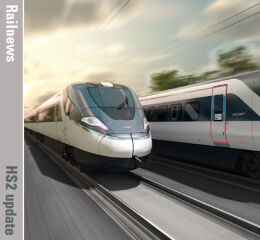Posted 14th June 2023 | 2 Comments
Two new HS2 directors will ‘robustly grip costs’–Minister

Transport secretary Mark Harper has appointed Keith Smithson and Joanna Davinson as new non-executive directors of HS2 Ltd.
The Department for Transport said Keith and Joanna will work alongside HS2 Ltd’s chair Sir Jonathan Thompson, to ‘provide oversight and accountability’ and ‘ensuring costs are controlled’ and the project completed ‘in the most effective way for taxpayers’. HS2 continues to be the focus of speculation about the future of London Euston as the city centre terminus. Work on the site has been paused for two years while the costs of building onwards from Old Oak Common are reviewed.
Joanna Davinson is a civil servant who has served as the executive director of the Central Digital and Data Office at the Cabinet Office, while Keith Smithson comes from the financial sector. He has already held several executive positions at organisations like HSBC, Paragon Banking Group and accountants KPMG.
Transport secretary Mark Harper said: ‘I’m delighted to make these updates to the board today and welcome Joanna and Keith to the team.
‘They bring with them a wealth of experience and I’m confident the right people are in place to robustly grip costs, hold HS2 Ltd to account and drive forward this revolutionary project.’
Deputy chair Elaine Holt and the government’s special director Ian King have been reappointed for a further four years. Dame Judith Hackitt and Stephen Hughes have also been reappointed as non-executive directors for a further three years. Mel Ewell and Roger Mountford left the Board recently as non-executive directors having completed full terms on the HS2 board.
Reader Comments:
Views expressed in submitted comments are that of the author, and not necessarily shared by Railnews.

John Porter, Leeds
I welcome the expertise on the HS2 board, but don’t see how David’s alternatives would provide extra peak capacity. Fast service frequencies to Northampton & Milton Keynes are already constrained by the number of paths allocated to longer distance services, which can only be removed by a new passenger alignment. Freight services don’t get paths in the peaks.
The Integrated Rail Plan implicitly allocated the Newcastle paths to Nottingham services and its supporting papers didn’t rule out improving the ECML as David advocates in the longer term.
Progress on HS2 ought to be welcomed, but needs to be accompanied by complementary proposals for areas which gain little from HS2. One quarter of passengers from Central Birmingham will eventually gain and use a direct connection with Crossrail 1 at Old Oak station. Telford, Wolverhampton, Coventry, Milton Keynes, Lichfield, Tamworth etc and other HS2 deprived towns deserve similar consideration.
Most would have benefited if the original Crossrail 2 aim - of linking Euston and Waterloo services to reduce rolling stock and driver requirements - had been a design parameter at HS2 Euston. That scheme should be kept alive for the 2050/60s during DfT’s 2 to 4 year reconsideration of HS2 Euston. A small sum should be spent now to keep that option open.
david C smith, Bletchley
There is a fundamental flaw with HS2 plans that seems to arise from trying to combine a capacity relief scheme with planning for a high speed (HS) line , with a West Coast alignment . Why ?
As for capacity relief, the HS2 scheme is a very expensive way to provide this.A predominantly freight relief could have been had for no more than £ 5bn, by following an ex Great Central routing via Calvert, between Neasden yard and Nuneaton ( most of which is still a working railway south of Calvert ). Passenger operations on the parallel WCML are then able to take over a greater share of WCML capacity .
There is little unmet demand for very high speeds between Birmingham / Manchester / Liverpool and Euston ,simply because these journeys are all too short to give a new surge in demand, as the train already beats the plane , centre to centre , and gives feasible day- returns. So Glasgow / Edinburgh to Euston in 3 hrs or less ( in order to acheive the same "step change" in market share) would again mean huge infrastructure expense ( according to a retired railway civil engineer).
Would it not have perhaps been more cost effective to have routed HS2 on an ECML alignment, with a series of 3 or 4 200 mph "cut off" sections in open country , separated by stretches of 140 mph track ( with cab signalling ) in the more built- up areas ? Trains such as Siemens Velaro 320 and Alstom AGV are already available. The main beneficiaries would be the Scottish Central Belt and Northeast England, and to a more limited extent, West Yorkshire. Estimated cost £ 25 to 35 bn. Installing cab signalling on WCML too might be worthwhile , to allow Pendolinos their top speed of 140 mph.
Unfortunately, it seems we're too late - the ship is pretty unlikely to be able to change course now.